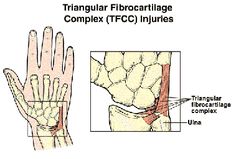Triangular Fibro Cartilage Tear or TFCC tear is an injury that is caused to the triangular fibrocartilage complex (TFCC). This complex is found in the wrist between the ulna bone and the carpals. The main function of TFCC is providing stability, cushioning and smooth movement to the wrist joint. It also stabilizes the radioulnar joint.

There are two types of tears:
- Type 1 Tears: are usually caused by falling on an outstretched hand and excessive arm rotation. These are also called traumatic tears.
- Type 2 Tears: occur over time with the wearing out of the cartilage with time. This type of tears is degenerative and chronic.
The symptoms common to a TFCC tear include:
- Pain at the base of the wrist, near the small finger.
- Bending of the wrist from side to side worsens the pain.
- Swelling in the wrist.
- Clicking of the wrist with pain.
- Loss of grip strength.
The doctor would also recommend the following tests to diagnose TFCC tear:
- X-Rays provide for clear images of the wrist joint to rule out any fractures.
- Magnetic Resonance Imaging (MRI) will give an idea of the soft tissue damage around the wrist joint.
Treatment
Non-Surgical Methods
The different non-surgical treatment options are:
- Rest: Giving proper rest to the wrist is the first step towards recovery. The patient is recommended to stay away from sports or strenuous activity that can aggravate the symptoms.
- Icing the Elbow: is recommended to be done for 20 to 30 minutes at intervals of 3-4 hours for two to three days. This will help reduce the pain and the swelling.
- Splint or Cast: is recommended by doctors to relieve the symptoms by providing immobilizing the wrist and forearm for 4 to 6 weeks, allowing the scar tissue to develop and healing the TFCC.
- Wrist Support Straps: can help in mild compression and minimize the movement of the wrist.
Non-Steroidal Anti-Inflammatory Drugs (NSAIDs): like Ibuprofen etc., can help reduce the pain and swelling.
- Steroid Injections: like cortisone can also help as anti-inflammatory medicines and help relieve the symptoms.
- Physical Therapy: is usually recommended with exercises for muscle strengthening and to reduce stiffness and increase flexibility.
- Electrotherapy: usually ultrasound is used.
Surgical Treatment
The doctors will recommend surgical interventions when the non-surgical treatment does not prove effective after 8-12 weeks. The existence of additional unstable or displaced fractures or unstable DRUJ can also make the doctors to recommend surgery.
The doctors usually opt for Arthroscopy technique for the following:
- Arthroscopic Debridement of TFC discus tissue
The central part of the TFC cannot heal because it has no blood supply. A tear in the TFC area creates an unstable tissue flap that can catch on other joint surfaces. Removing or debridement of this damaged tissue is required.
- Arthroscopic Repair of TFCC Ligaments
The repair of the TFCC ligaments by suturing using the Arthroscopy technique is common. The ligaments and the surrounding structures face no serious damage. The torn ligaments will retract and lose length after some time and are not possible to re-suture again and reconstruction might be required.


